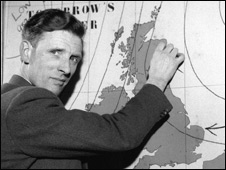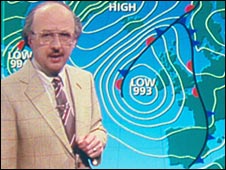Lovely Day Today... 有150年歷史的氣象預報
Lovely Day Today... 有150年歷史的氣象預報
英語學習點: Weather Forecasting 天氣預報

A TV weather forecast in 1954
Starting with the lines "General weather probable in the next two days," a short piece in The Times newspaper of London in 1861 started forecasting as we know it today.
It was put together by Robert FitzRoy, a captain in the Royal Navy and a pioneer in the field of meteorology, who led the department which later became the Met Office.
收聽與下載
In the 150 years since then, the unreliable art has gone through many different styles, but one thing has remained constant: ridicule for weathermen when they get it wrong. Poor FitzRoy became the butt of jokes when his predictions were incorrect and his daily forecasts soon stopped.
However, by popular demand, they returned a few years later. The first BBC radio weather bulletin was in 1922 but it wasn't until 1949 that forecasts made it onto TV.
Unlike modern weather forecasts with high-tech graphics and chroma key technology, the presenter used just a map and a pencil to show what the weather would be doing tomorrow.

Michael Fish presenting the TV weather forecast
It goes without saying that weather forecasting is far more important than simply letting people know whether to take waterproofs and an umbrella out with them. Early-warning systems which predict extreme weather such as hurricanes and cyclones have saved countless lives.
Come rain or shine, weather forecasts will probably be here for at least another 150 years. After all, what would the British talk about without them?
Glossary 詞匯表 (收聽發音, 請單擊英語單詞)
- forecasting 預報
- meteorology 氣象學
- Met Office 氣象局
- weathermen 氣象預報員
- bulletin 簡報
- high-tech graphics 高技術圖像
- chroma key technology 色鍵技術
- waterproofs 防水的
- early-warning systems 早期預告系統
- hurricanes 颶風
- cyclones 旋風/颶風
- come rain or shine 不論下雨還是晴天